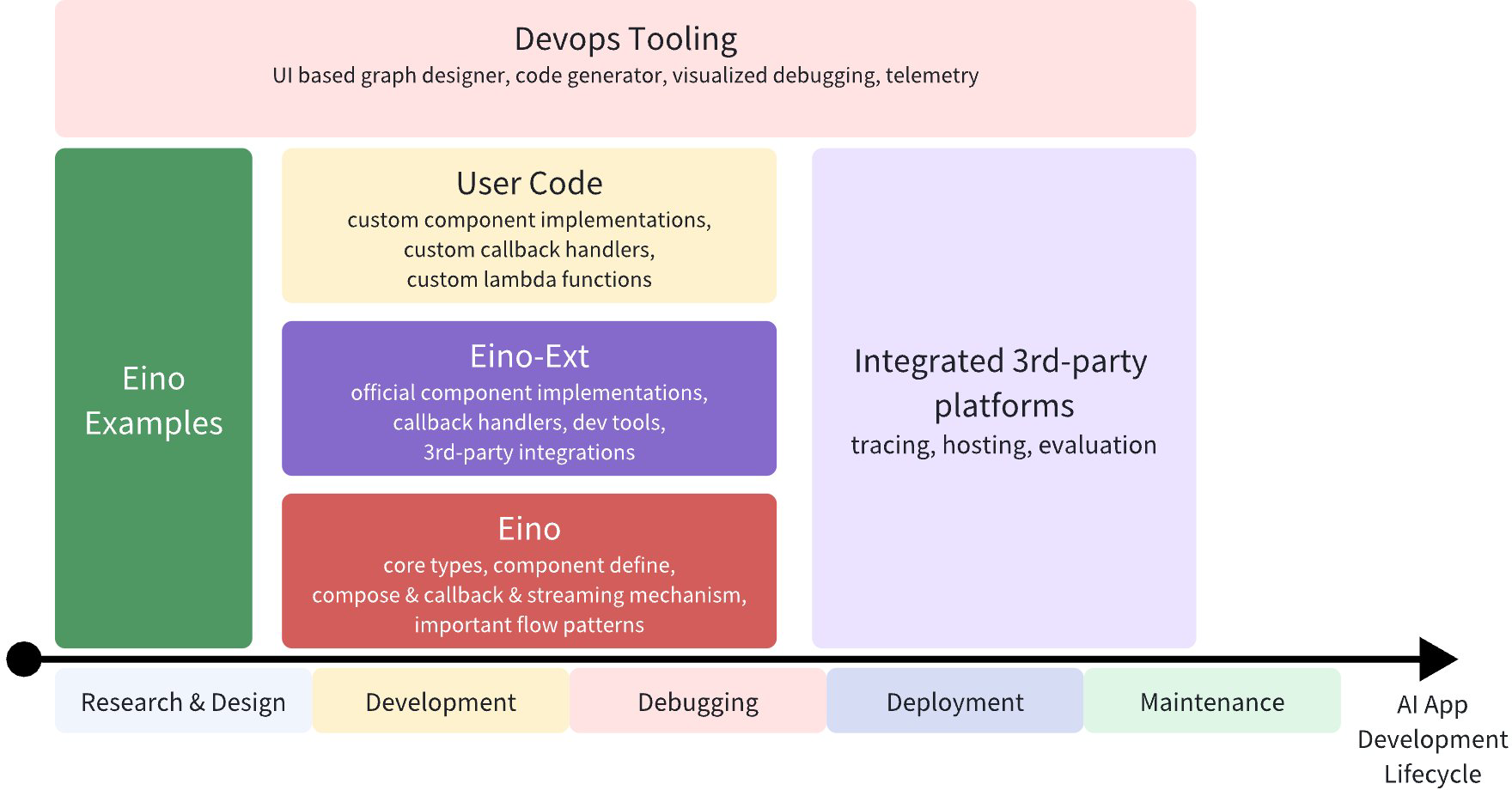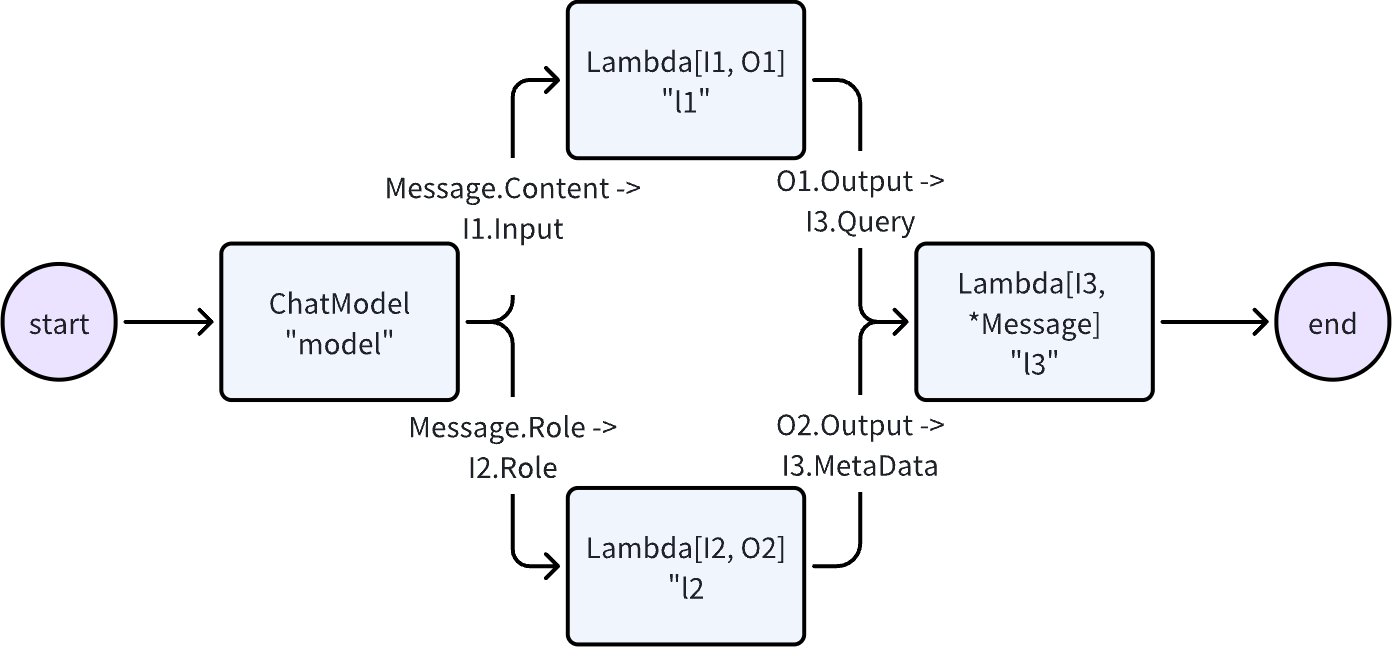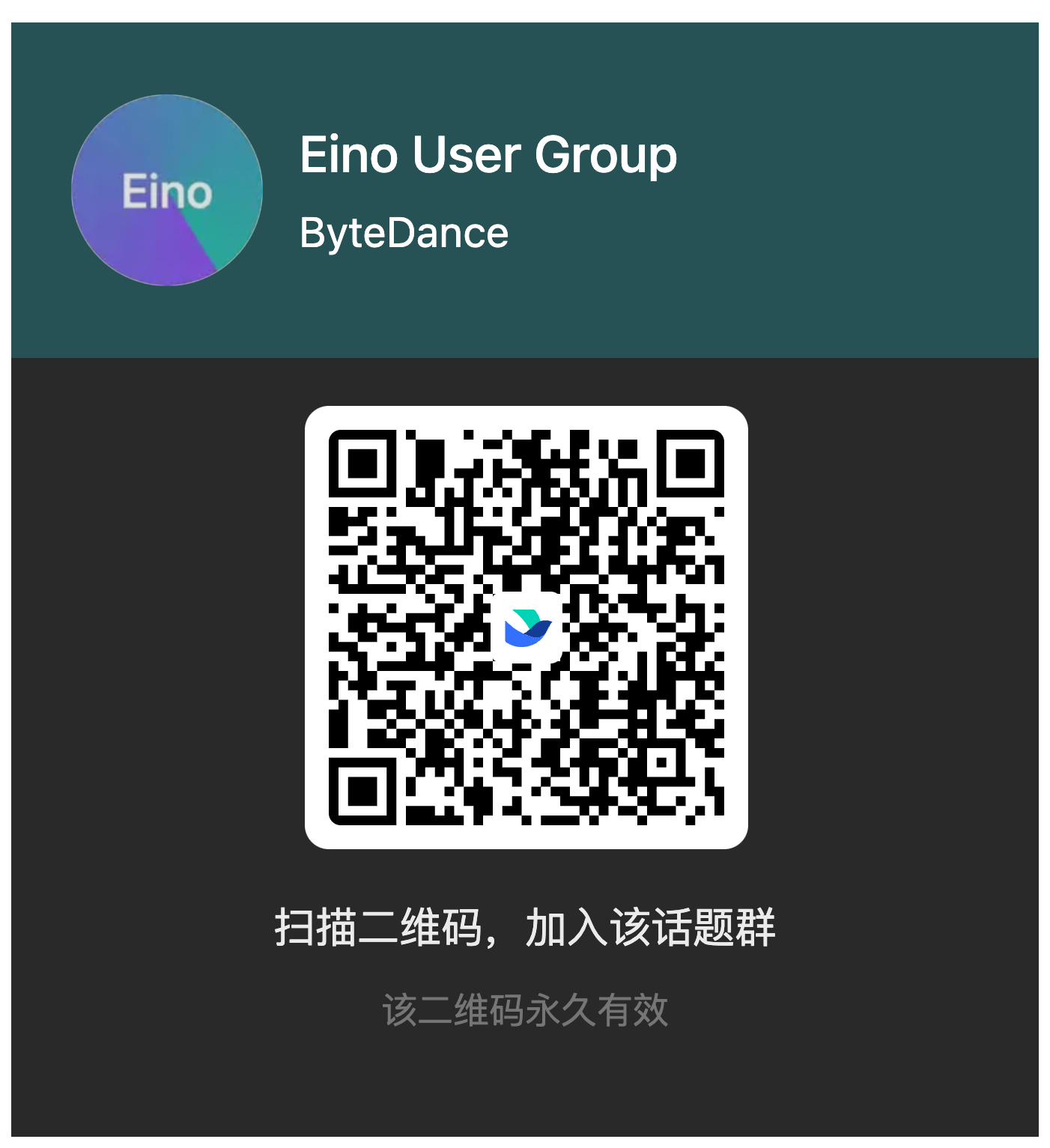Eino: 概述
简介
Eino[‘aino] (近似音: i know,希望框架能达到 “i know” 的愿景) 旨在提供基于 Go 语言的终极大模型应用开发框架。 它从开源社区中的诸多优秀 LLM 应用开发框架,如 LangChain 和 LlamaIndex 等获取灵感,同时借鉴前沿研究成果与实际应用,提供了一个强调简洁性、可扩展性、可靠性与有效性,且更符合 Go 语言编程惯例的 LLM 应用开发框架。
Eino 提供的价值如下:
- 精心整理的一系列 组件(component) 抽象与实现,可轻松复用与组合,用于构建 LLM 应用。
- 强大的 编排(orchestration) 框架,为用户承担繁重的类型检查、流数据处理、并发管理、切面注入、选项赋值等工作。
- 一套精心设计、注重简洁明了的 API。
- 以集成 流程(flow) 和 示例(example) 形式不断扩充的最佳实践集合。
- 一套实用 工具(DevOps tools),涵盖从可视化开发与调试到在线追踪与评估的整个开发生命周期。
借助上述能力和工具,Eino 能够在人工智能应用开发生命周期的不同阶段实现标准化、简化操作并提高效率:
快速上手
直接使用组件:
model, _ := openai.NewChatModel(ctx, config) // create an invokable LLM instance
message, _ := model.Generate(ctx, []*Message{
SystemMessage("you are a helpful assistant."),
UserMessage("what does the future AI App look like?")})
当然,你可以这样用,Eino 提供了许多开箱即用的有用组件。但通过使用编排功能,你能实现更多,原因有三:
- 编排封装了大语言模型(LLM)应用的常见模式。
- 编排解决了处理大语言模型流式响应这一难题。
- 编排为你处理类型安全、并发管理、切面注入以及选项赋值等问题。
Eino 提供了三组用于编排的 API:
| API | 特性和使用场景 |
| Chain | 简单的链式有向图,只能向前推进。 |
| Graph | 有向有环或无环图。功能强大且灵活。 |
| Workflow | 有向无环图,支持在结构体字段级别进行数据映射。 |
我们来创建一个简单的 chain: 一个模版(ChatTemplate)接一个大模型(ChatModel)。
chain, _ := NewChain[map[string]any, *Message]().
AppendChatTemplate(prompt).
AppendChatModel(model).
Compile(ctx)
chain.Invoke(ctx, map[string]any{"query": "what's your name?"})
现在,我们来创建一个 Graph,一个 ChatModel,要么直接输出结果,要么最多调一次 Tool。
graph := NewGraph[map[string]any, *schema.Message]()
_ = graph.AddChatTemplateNode("node_template", chatTpl)
_ = graph.AddChatModelNode("node_model", chatModel)
_ = graph.AddToolsNode("node_tools", toolsNode)
_ = graph.AddLambdaNode("node_converter", takeOne)
_ = graph.AddEdge(START, "node_template")
_ = graph.AddEdge("node_template", "node_model")
_ = graph.AddBranch("node_model", branch)
_ = graph.AddEdge("node_tools", "node_converter")
_ = graph.AddEdge("node_converter", END)
compiledGraph, err := graph.Compile(ctx)
if err != nil {
return err
}
out, err := compiledGraph.Invoke(ctx, map[string]any{
"query":"Beijing's weather this weekend"})
现在,我们来创建一个 Workflow,它能在字段级别灵活映射输入与输出:
wf := NewWorkflow[[]*Message, *Message]()
wf.AddChatModelNode("model", model).AddInput(START)
wf.AddLambdaNode("l1", lambda1).AddInput("model", MapFields("Content", "Input"))
wf.AddLambdaNode("l2", lambda2).AddInput("model", MapFields("Role", "Role"))
wf.AddLambdaNode("l3", lambda3).AddInput("l1", MapFields("Output", "Query")).
AddInput("l2", MapFields("Output", "MetaData"))
wf.AddEnd("node_l3")
runnable, _ := wf.Compile(ctx)
runnable.Invoke(ctx, []*Message{UserMessage("kick start this workflow!")})
现在,咱们来创建一个 “ReAct” 智能体:一个 ChatModel 绑定了一些 Tool。它接收输入的消息,自主判断是调用 Tool 还是输出最终结果。Tool 的执行结果会再次成为聊天模型的输入消息,并作为下一轮自主判断的上下文。
我们在 Eino 的 flow 包中提供了开箱即用的 ReAct 智能体的完整实现。代码参见: flow/agent/react
Eino 会在上述代码背后自动完成一些重要工作:
- 类型检查:在编译时确保两个节点的输入和输出类型匹配。
- 流处理:如有需要,在将消息流传递给 ChatModel 和 ToolsNode 节点之前进行拼接,以及将该流复制到 callback handler 中。
- 状态管理:确保共享的 state 可以被安全地读写。
- 切面注入:如果指定的 ChatModel 实现未自行注入,会在 ChatModel 执行之前和之后注入回调切面。
- 选项赋值:运行时 Option 可以全局设置,也可以针对特定组件类型或特定节点进行设置。
例如,你可以轻松地通过回调扩展已编译的图:
handler := NewHandlerBuilder().
OnStartFn(
func(ctx context.Context, info *RunInfo, input CallbackInput) context.Context {
log.Infof("onStart, runInfo: %v, input: %v", info, input)
return ctx
}).
OnEndFn(
func(ctx context.Context, info *RunInfo, output CallbackOutput) context.Context {
log.Infof("onEnd, runInfo: %v, out: %v", info, output)
return ctx
}).
Build()
compiledGraph.Invoke(ctx, input, WithCallbacks(handler))
或者你可以轻松地为不同节点分配选项:
// assign to All nodes
compiledGraph.Invoke(ctx, input, WithCallbacks(handler))
// assign only to ChatModel nodes
compiledGraph.Invoke(ctx, input, WithChatModelOption(WithTemperature(0.5))
// assign only to node_1
compiledGraph.Invoke(ctx, input, WithCallbacks(handler).DesignateNode("node_1"))
关键特性
丰富的组件(Component)
- 将常见的构建模块抽象为组件,每个组件抽象都有多个可开箱即用的组件实现。
- 诸如聊天模型(ChatModel)、工具(Tool)、提示模板(PromptTemplate)、检索器(Retriever)、文档加载器(Document Loader)、Lambda 等组件抽象。
- 每种组件类型都有其自身的接口:定义了输入和输出类型、定义了选项类型,以及合理的流处理范式。
- 实现细节是透明的。在编排组件时,你只需关注抽象层面。
- 实现可以嵌套,并包含复杂的业务逻辑。
- ReAct 智能体(React Agent)、多查询检索器(MultiQueryRetriever)、主机多智能体(Host MultiAgent)等。它们由多个组件和复杂的业务逻辑构成。
- 从外部看,它们的实现细节依然透明。例如在任何接受 Retriever 的地方,都可以使用 MultiQueryRetriever。
强大的编排 (Graph/Chain/Workflow)
- 数据从 Retriever / Document Loader / ChatTemplate 流向 ChatModel,接着流向 Tool ,并被解析为最终答案。这种通过多个组件的有向、可控的数据流,可以通过图编排来实现。
- 组件实例是图的 节点(Node) ,而 边(Edge) 则是数据流通道。
- 图编排功能强大且足够灵活,能够实现复杂的业务逻辑:
- 类型检查、流处理、并发管理、切面注入和选项分配都由框架处理。
- 在运行时进行分支(Branch)执行、读写全局状态(State),或者使用工作流进行字段级别的数据映射。
完善的流处理(Streaming)
- 流数据处理(Stream Processing)很重要,因为 ChatModel 在生成消息时会实时输出完整消息的各个分片。在编排场景下会尤为重要,因为更多的组件需要处理分片的消息数据。
- 对于只接受非流式输入的下游节点(如 ToolsNode),Eino 会自动将流 拼接(Concatenate) 起来。
- 在图的执行过程中,当需要流时,Eino 会自动将非流式转换为流式。
- 当多个流汇聚到一个下游节点时,Eino 会自动 合并(Merge) 这些流。
- 当一个流传入到多个不同的下游节点或传递给回调处理器时,Eino 会自动 复制(Copy) 这些流。
- 如 分支(Branch) 、或 状态处理器(StateHandler) 等编排元素,也能够感知和处理流。
- 借助上述流数据处理能力,组件本身的“是否能处理流、是否会输出流”变的对用户透明。
- 经过编译的 Graph 可以用 4 种不同的流输入输出范式来运行:
| 流处理范式 | 解释 |
| Invoke | 接收非流类型 I ,返回非流类型 O |
| Stream | 接收非流类型 I , 返回流类型 StreamReader[O] |
| Collect | 接收流类型 StreamReader[I] , 返回非流类型 O |
| Transform | 接收流类型 StreamReader[I] , 返回流类型 StreamReader[O] |
易扩展的的切面(Callbacks)
- 切面用于处理诸如日志记录、追踪、指标统计等横切面关注点,同时也用于暴露组件实现的内部细节。
- 支持五种切面:OnStart、OnEnd、OnError、OnStartWithStreamInput、OnEndWithStreamOutput。
- 开发者可以轻松创建自定义回调处理程序,在图运行期间通过 Option 添加它们,这些处理程序会在图运行时被调用。
- 图还能将切面注入到那些自身不支持回调的组件实现中。
Eino 框架结构
Eino 框架由几个部分组成:
💡 针对字节内部使用的组件,有对应的内部代码仓库:
EinoBytedExt: https://code.byted.org/search/flow/eino-byted-ext
包含当前定位为内部使用的组件实现,如 llmgateway, bytedgpt, fornax tracing, bytees 等。
- Eino Devops:可视化开发、可视化调试等。
- EinoExamples:是包含示例应用程序和最佳实践的代码仓库。
详见:[Eino 框架结构说明](/zh/docs/eino/overview/Eino 框架结构说明)
详细文档
针对 Eino 的学习和使用,我们提供了完善的 Eino 用户手册,帮助大家快速理解 Eino 中的概念,掌握基于 Eino 开发设计 AI 应用的技能,赶快通过 Eino 用户手册尝试使用吧~。
若想快速上手,了解 通过 Eino 构建 AI 应用的过程,推荐先阅读 Eino: 快速开始
完整 API Reference:https://pkg.go.dev/github.com/cloudwego/eino
依赖说明
- Go 1.18 及以上版本
- Eino 依赖了 kin-openapi 的 OpenAPI JSONSchema 实现。为了能够兼容 Go 1.18 版本,我们将 kin-openapi 的版本固定在了 v0.118.0。
安全
如果你在该项目中发现潜在的安全问题,或你认为可能发现了安全问题,请通过我们的安全中心或漏洞报告邮箱通知字节跳动安全团队。
请不要创建公开的 GitHub Issue。
联系我们
- 如何成为 member: COMMUNITY MEMBERSHIP
- Issues: Issues
- 飞书用户群(注册飞书后扫码进群)
- 字节内部 OnCall 群
开源许可证
本项目依据 [Apache-2.0 许可证]授权。





